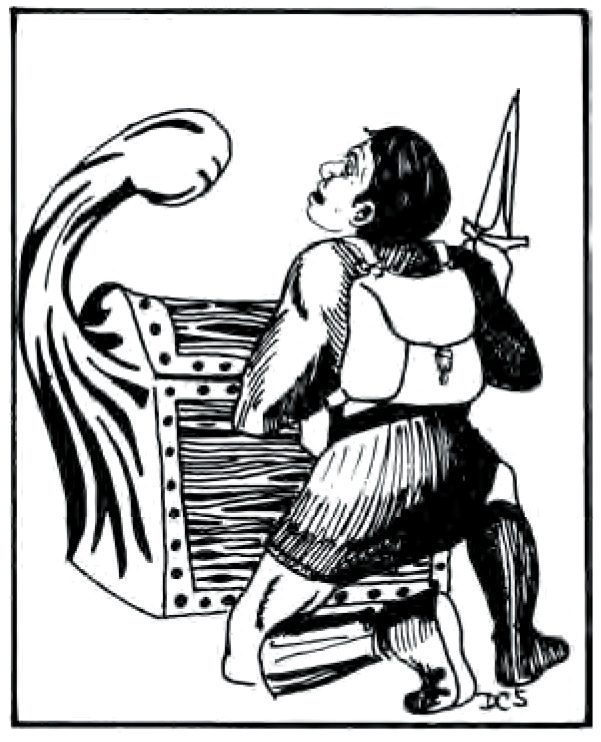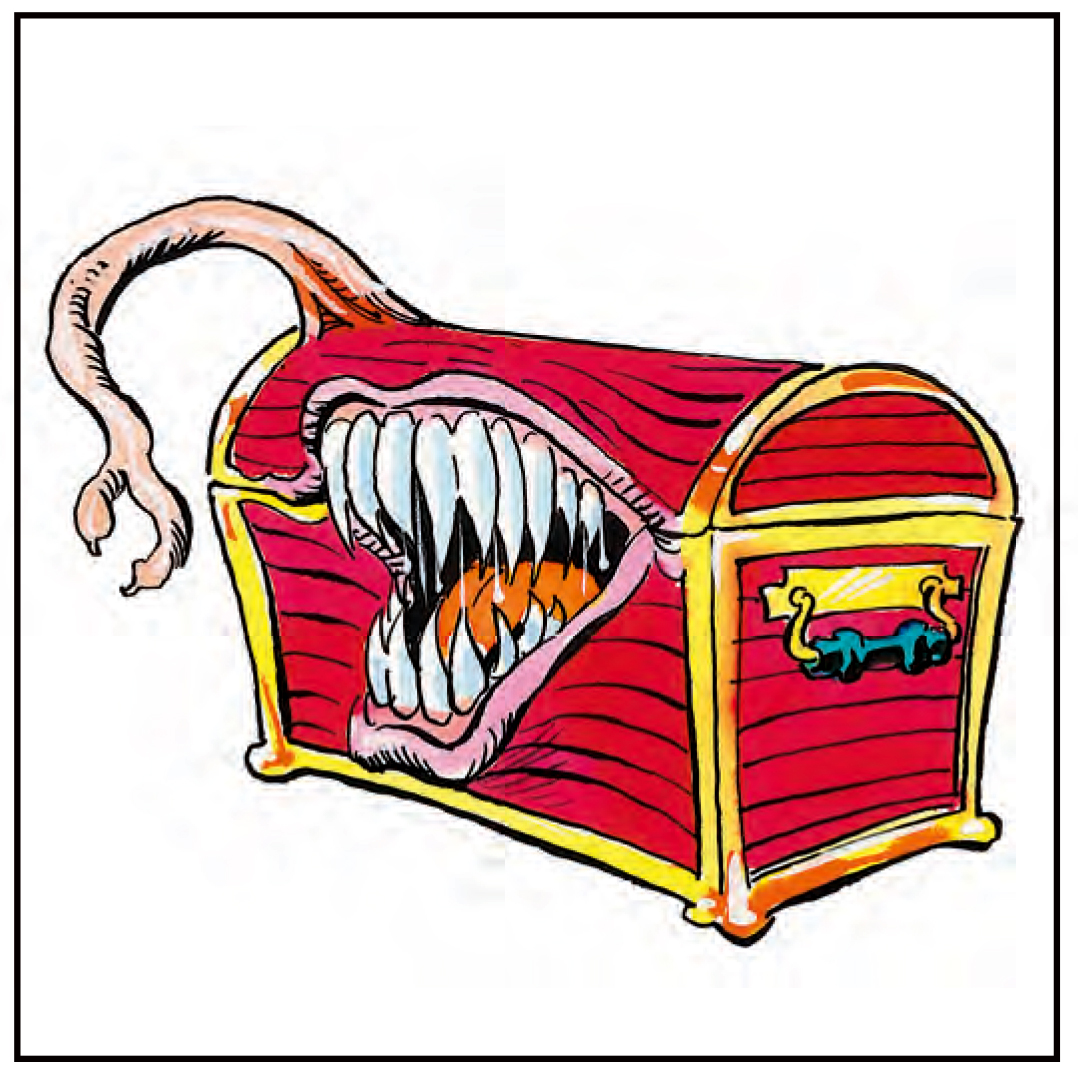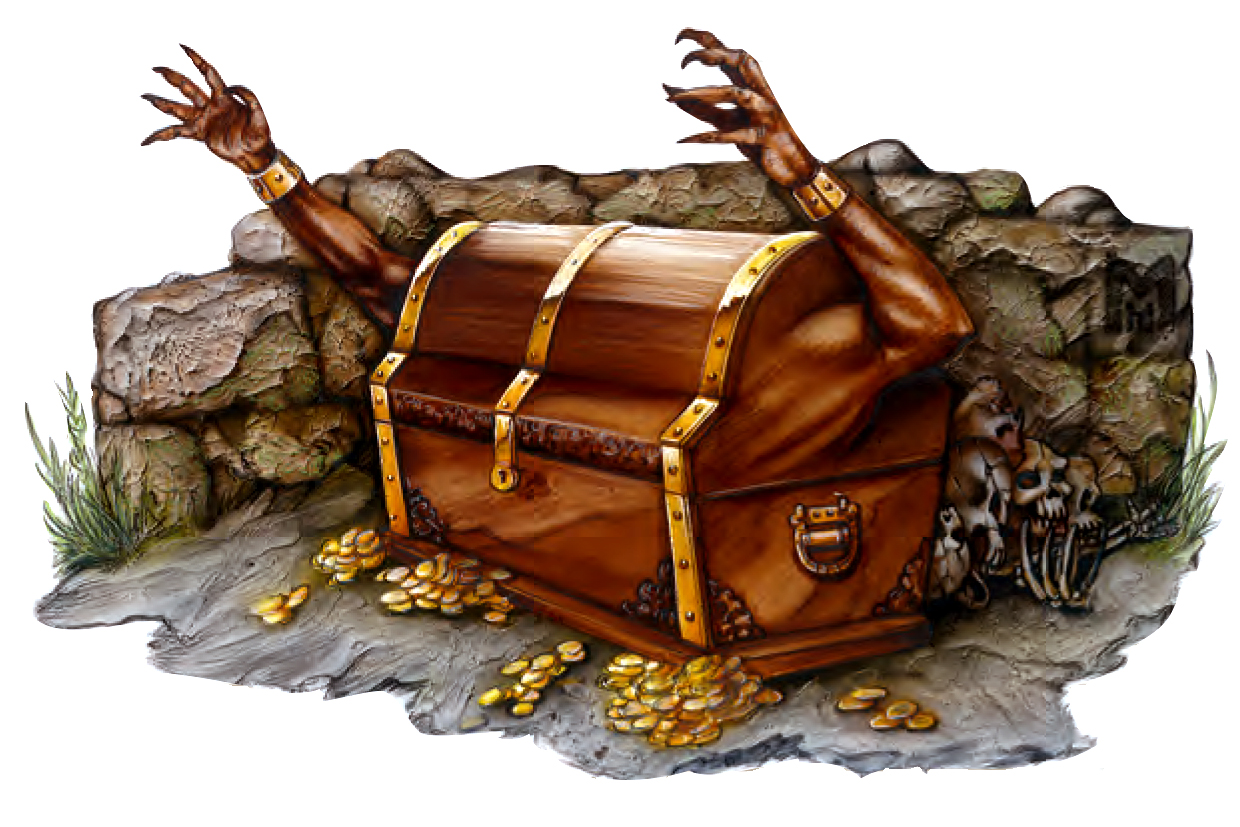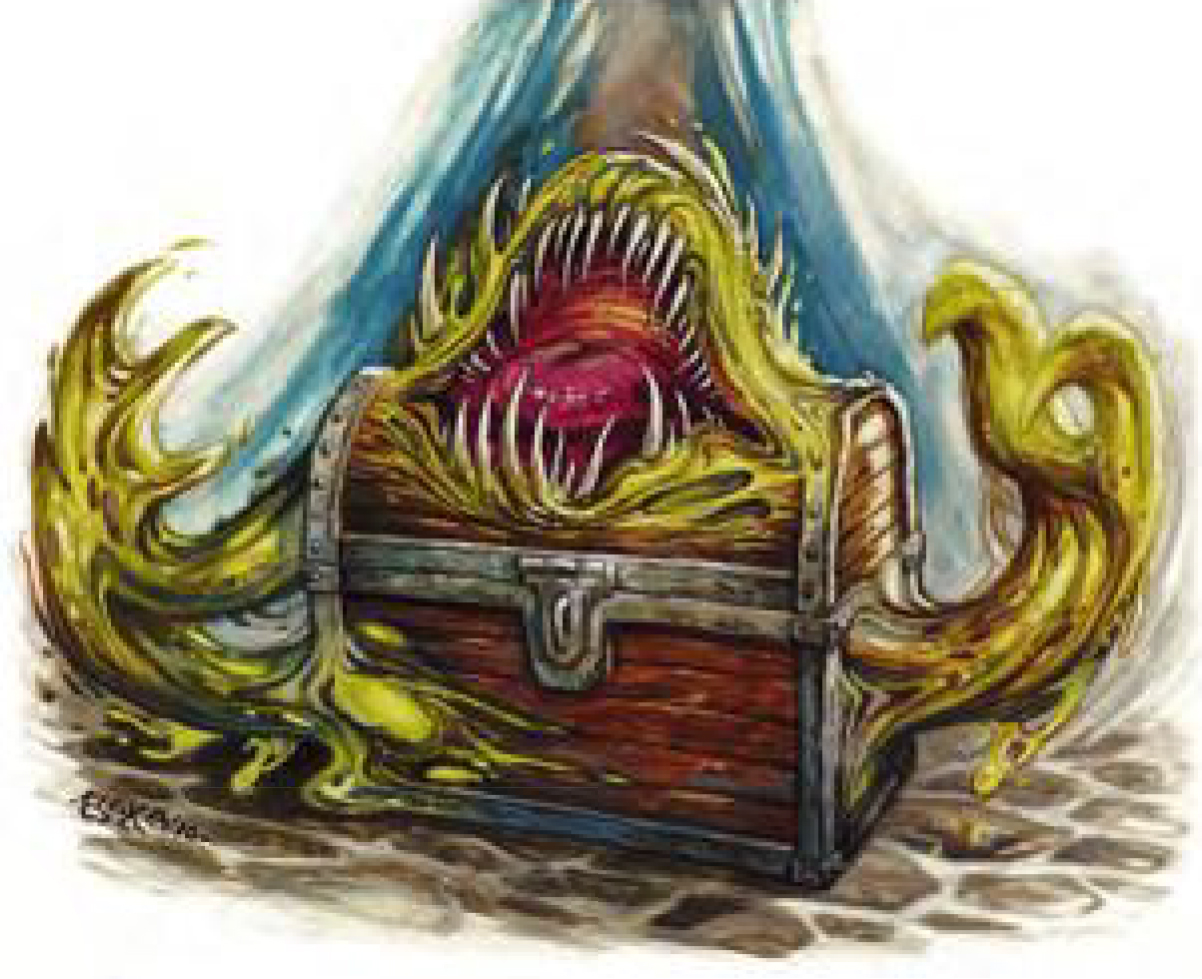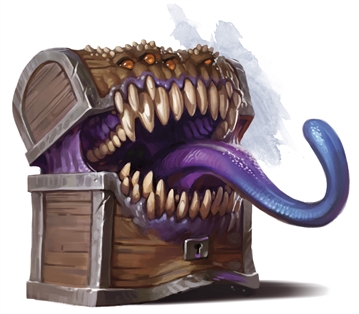Deep Dive - The Mimic
This one is for my daughter Claire. She thinks Mimics are cool.
Mimics. The strange shapeshifting goo-like creature that becomes a perfect representation of whatever it needs to trick people into wanting to touch it. How did this stress inducing monster come to be? Who do we have to thank for this abomination? Gary Gygax of course, though Ed Greenwood fleshed them out a lot in 1983 when he wrote The Ecology of the Mimic… but we will get to that!
The mimic has been the source of countless memes, T-shirts, and various other products over time. But why do these horrible creatures seem to get so much love? For a DM, it’s fun to throw at new players. Many have never encountered a mimic before, and even those experienced players that should know better, don’t take the time to do an investigation check on that suspicious chest in the middle on an empty room. The most hardened and seasoned player can still get surprised by a mimic… But unlike many of the creatures in D&D, the mimic will usually elicit laughter from the party when it attacks, not the sense of complete horror when it’s the Tarrasque.
Let’s take a look at how the mimic came to be and how it has progressed through the editions.
1e
Frequency: Rare
No. Appearing: 1
Armor Class: 7
Move: 3"
Hit Dice: 7- 10
% in Lair: Nil
Treasure Type: Nil
No. of Attacks: 1
Damage/Attack: 3-12
Special Attacks: Glue
Special Defenses: Camouflage
Magic Resistance: Standard
Intelligence: Semi- to average
Alignment: Neutral
Size: L
Psionic Ability: Nil
Attack/Defense Modes: Nil
First off, Mimics can only be found underground. AD&D was mostly a dungeon crawl in its early days, so like most creatures, underground is the location to be. It also makes sense since they cannot stand sunlight, but this is also the fallback reason for most creatures found underground. That giant, yellow orb in the sky really gets no love in early D&D.
Monster Manual, 1977 TSR, Inc.
Mimics have a fairly poor AC, as an AC 7 is below average (remember, the lower the AC the better!). They also don’t do that much damage, as they are limited to one attack which only does 3-12 (3d4) points of damage. Now Killer Mimics do get a decent amount of HP to play with, as they have an average of 64 HP. What really hurts is the glue that the mimic uses. The wording is quite odd when describing how the glue works, “…the mimic excretes a glue which holds fast whatever member the creature touched the mimic with.” (AD&D MM, pg. 70) So the word “member” throws me off, not to mentions sends my mind straight into the gutter.
Touching the mimic causes your hand to get stuck, kicking it gets your foot stuck, so on and so forth. But does this mean that any weapons that touch the mimic will also be stuck? I assume yes, maybe not if they are magic weapons, but it’s not quite clarified enough, like many things in the early editions. Also, there is no mention of the player being able to break free. This seems like a bit of an oversight, but I can just imagine a fighter having to drag along the dead weight of these weird amorphous creature cause they forgot to bring a backup weapon.
Furthermore, mimics can only be stone or wood. This becomes a little more flexible in later editions, but in a dungeon crawl, this makes some sense. The Monster Manual states that “Mimics can pose as stonework, doors, chests, or any other substance or item they can imitate.” (AD&D 1st ed. MM, pg. 70) The last part of the sentence gives the DM so much room to create untold horrors for their party, anything from stone thrones to wooden beds to maybe even the entire dungeon room!
Speaking of entire dungeon rooms, in Dungeon magazine No. 19 (October 1989), an adventure is written about a vanishing village. In truth, it was massive mimics the size of houses and inns that would eat travelers on the road. If that doesn’t give you some great ideas for a random encounter, let me point you to another magazine; Dragon magazine No. 75 (July 1983) which provides an article on The Ecology of the Mimic. This, almost scientific, look at the mimic provides great information about exactly what a mimic is and how it’s inner capillaries can move brown pigments to the top of its stone-looking skin to look like wood.
One last thing before we head into 2e, AD&D gives us some interesting mimics to throw at our players. Not only do we have the stereotypical ever-hungry-killer mimic, but we also have the friendly and smaller mimic. This mimic will be friendly toward the players if they offer it some food and I assume don’t hit it with their magic and swords. The Monster Manual goes on to say that these mimics speak a number of languages, including common, so the party has a decent chance of talking to it. If the party is friendly to the mimic and feeds it, there is a decent chance it will tell the party what it knows in the surrounding area. That’s way better than a murderhobo chest intent on making you its snack.
2e
There are several different mimics in 2e, we are just going to focus on three of them. The first one brought to life is the Mimic, Greater in the 1989 Monstrous Compendium Annual Volume 2, followed by two smaller versions: the Common and Killer Mimic. A type of mimic worth mentioning are the House Hunters, mimics the size of houses that travel in packs and one other, but we will talk about that at the end of 2e.
Climate/Terrain: Subterranean (Common, Greater, Killer)
Frequency: Rare (Common & Killer) / Very Rare (Greater)
Organization: Solitary (Common, Greater, Killer)
Activity Cycle: Any (Common, Greater, Killer)
Diet: Carnivore (Common, Greater, Killer)
Treasure: Incidental (Common & Killer) / Nil (Greater)
Intelligence: Common: Average (8-10) / Killer: Semi- (2-4) / Greater: High (12-14)
Alignment: Neutral (Common, Greater, Killer)
No. Appearing: 1 (Common, Greater, Killer)
Armor Class: 7 (Common & Killer) / 5 internal, 2 external (Greater)
Movement: 3 (Common & Killer) / 1 (Greater)
Hit Dice: Common: 7-8 / Killer: 9-10 / Greater: 15 or 16
THAC0: Common: 13 / Killer: 11 / Greater: 5
No. of Attacks: 1 (Common, Greater, Killer)
Damage/Attack: 3-12 (Common & Killer) / 6d4 (Greater)
Special Attacks: Glue (Common, Greater, Killer)
Special Defenses: Camouflage (Common, Greater, Killer)
Magic Resistance: Nil (Common & Killer) / 10% (Greater)
Size: L (Common & Killer) / H: 1,000+ cu. ft. (Greater)
Morale: Common: Champion(15) / Killer: Elite (13) / Greater: Fanatic (17)
XP Value: 7 HD - 975 / 9 HD - 2000 / 8 HD - 1400 / 10 HD - 3000 (Common & Killer) / 7,000 - 8,000 (Greater)
Monstrous Manual, 1993 TSR Inc.
2e a lot more detail about our three types of mimic: Common, Greater and Killer. While they are alike in many ways, the biggest difference is that one will kill you at the first chance, the other has the potential to be “friendly”, and the last one is massive and will kill you at the first chance.
As with the AD&D edition, Common Mimic can be very forthcoming with information about the surrounding area if you give them a little bit of food. The Killer and Greater… not so much as you are their food.
Combat is pretty similar to AD&D, but we are given more information. For the two lesser types, Common and Killer, they still only deal 3d4 damage on a hit while the Greater deals 6d4. The books also go into more detail about the mimic, including the fact that the mimic’s glue that holds things to it will dissolve after only five rounds… though five rounds in the middle of combat may be enough to kill even the hardiest barbarian if they get unlucky and can’t break free from the dead mimic’s hold. Speaking of, we are finally given information on how to break free. The character has ONLY ONE chance to make an Open Door Check to break free, or else they are held fast and can’t do anything else on their round. Though, if a character pours alcohol on the mimic, the glue will dissolve in three rounds and any stuck characters will be released, so that’s something!
2e dives into a deeper background for the mimics and even talks a bit more about their ecology. Mimics were created by by wizards and used to protect their treasures, though most wizards don’t find them super helpful as they don’t like to follow orders. Mimics apparently then developed into a solitary race that feed in dungeons and underground lairs and created their own language… somehow. A good meal, consisting of 1-2 humanoids, can satisfy a mimic’s hunger for weeks. What is also pretty neat is the mimic is able to excrete a foul smelling liquid that will attract small common prey. When those pesky adventurers are taking the week off, a couple of rats can tide them over.
Monstrous Compendium - Annual Volume 2, 1995 TSR Inc.
And our final remark pertains to the Greater Mimic: Due to its size, it chooses to not disguise itself as a pile of treasure, but rather as an entire room. It can also decorate its internals with furniture, illusory people and so much more. When a band of adventurers decides that that one room with all the nice furniture would be a great place to take a rest… it just simply closes the door (Read: its mouth) and begins attacking and eating the adventurers inside of it. Now, it doesn’t make any mention of an entire dungeon being a mimic… but I have such a wonderful, terrible idea for my next campaign…
Now, technically I did say that that was my final remark… but I can’t leave you without this last bit of information… There is a Space Mimic and it lives in the “wildspace” between planetary bodies… so not even space is safe. I’ve heard this well furnished dungeon is safe though!
3.5e
Large Aberration (Shapechanger)
Hit Dice: 7d8+21 (52 hp)Initiative: +1
Speed: 10 ft. (2 squares)
Armor Class: 15 (–1 size, +1 Dex, +5 natural), touch 10, flat-footed 15
Base Attack/Grapple: +5/+13
Attack: Slam +9 melee (1d8+4)
Full Attack: 2 slams +9 melee (1d8+4)
Space/Reach: 10 ft./10 ft.
Special Attacks: Adhesive, crush
Special Qualities: Darkvision 60 ft., immunity to acid, mimic shape
Saves: Fort +5, Ref +5, Will +6
Abilities: Str 19, Dex 12, Con 17, Int 10, Wis 13, Cha 10
Skills: Climb +9, Disguise +13, Listen +8, Spot +8
Feats: Alertness, Lightning Reflexes, Weapon Focus (slam)
Environment: Underground
Organization: Solitary
Challenge Rating: 4
Treasure: 1/10th coins; 50% goods; 50% items
Alignment: Usually neutral
Advancement: 8–10 HD (Large); 11–21 HD (Huge)
Monster Manual, 2000 WotC
3/3.5e scaled back the craziness of the mimic by only having one mimic statblock in the Monster Manual (2000, 2003 for 3.5). No longer are there separate mimics to trick your party with, they are turned into a single creature and they now only speak Common. While their base HP is a little lower now, they do have the potential to have a lot more HP depending on the size, and of course, how vicious your DM is. It’s AC is buffed slightly but not so much as to make them much harder to kill. Their damage is also increased a little, now doing a minimum of 5 points of damage instead of 3, plus any creature stuck to the mimic automatically gets one attack made against them… so don’t get stuck.
Weapons and what happens to them are now spelled out; when you hit them you must make a DC 16 Reflex save. Failing that, you have to make a DC 16 Strength check to pull your weapon out. All other information about the mimic and their annoying glue stays the same: alcohol can dissolve it, mimics can dissolve their glue at will and it takes 5 round after they die for the glue to dissolve.
Interestly enough, the mimic gets dumber in this version, and by a lot. It can still speak common, but their intelligence is dropping. While they still know enough to bargain for food with adventurers, the mimic can be “extorted” to give up it’s treasure. No more information about the surrounding area, but I’m fairly sure the players will give up the information for the promise of riches.
4e
Object Mimic - Level 8 Lurker
Medium aberrant magical beast, XP 350
Initiative +11 / Senses Perception +14, darkvision, tremorsense 5
HP 71; Bloodied 35
AC 23; Fortitude 21, Reflex 19, Will 21 / Resist 5 acid
Speed 5
(Trait) Ambush - The object mimic deals 2d6 extra damage against surprised creatures.
> Slam (standard, at-will) • Melee (1) +13 vs. AC; Hit: 2d8 + 7 damage
> Crushing Tendrils (acid) (standard, at-will) • Melee (3) +13 vs. AC Hit: 1d8 + 4 damage, and the mimic grabs the target. The target takes a –5 penalty to attempts to escape the grab. / Sustain Standard: The object mimic sustains the grab, and the target takes 15 acid damage.
> Ravening Maw (standard, recharge 5-6) • Melee (2) +13 vs. AC Hit: 2d8 + 11 damage, and the target is slowed (save ends).
> Shapeshift (polymorph) (minor, at-will, 1/round) Effect: The mimic assumes one of the following forms. It can’t change its size. It remains in the chosen form until it uses this power again.
Ooze Form: The mimic becomes an ooze. When it squeezes while it is in this form, it moves at full speed rather than half speed, it doesn’t take the –5 penalty to attack rolls, and it doesn’t grant combat advantage for squeezing,
Object Form: While in this form, the mimic has resist 10 to all damage, is immobilized, and cannot attack. In addition, a creature must succeed on a DC 24 Perception check to notice that the mimic is a living creature.
Alignment unaligned / Languages Common, Deep Speech
Skills Bluff +11, Stealth +12
Str 20 (+9) | Dex 16 (+7) | Wis 21 (+9) | Con 17 (+7) | Int 19 (+8) | Cha 15 (+6)
Monster Manual 3, 2010 WotC
Ah, blessed 4e. Mimics are found in the Monster Manual III, which seems odd with it being such a classic monster and being one of the most well known monster in all of DnD so much so as being added into other games and content. Then again, the Mind Flayer was also relegated to the same book, so we aren’t quite sure what happened here. Where 3.5e scales the mimic down to only one type, 4e created three different types of mimics, with the Impersonator Mimic being as awesome as it is deadly.
But first, the Object Mimic is the traditional mimic that we have been working with since AD&D. The party walks into a room, there’s a chest in the corner, the greedy rogue goes up to open it up and mayhem ensues. This mimic has been buffed a decent amount. It’s HP is now up to 71, and it’s AC takes a big jump to 23. Though it’s the damage where this mimic really increases in power. If the mimic surprises the character, which is now a DC 24 perception check, then it deals an extra 2d6 damage on the ambush… So that is new and it sucks for the players, but the cackling of the DM will pry drown out their crying.
There are also a variety of different attacks the typical mimic can make. The Slam is the standard attack the mimic has had in every version, and the damage is increased to 2d8+7. The “glue ability” is now described as Crushing Tendrils, this attack does 1d8+4, which is the same as the previous versions slam attack, but they now grapple their prey on this attack. When the mimic maintains this grapple on the character, the target takes 15 acid damage. Oof. Finally, this mimic now gets a Ravening Maw attack. This is its most powerful attack, as a successful hit deals 2d8+11 points of damage and the player is slowed.
The form of the Object Mimic is broken out into two forms in 4e. It’s Object form is what we what we normally think of when we think of a mimic, while it cannot move in this form, it does get a hefty +10 to its resist all damage. The downside is it cannot attack, so once the player is surprised, it immediately changes into its Ooze form and attacks. The ooze form also allows the mimic to escape if the battle is going poorly for it. This form allows the mimic to squeeze through smaller areas that the party may not be able to. Once it has fled to a safe place, it will revert back to object form, most likely taking on the appearance of part of the wall or ceiling to avoid being discovered.
Now we can get to the Impersonator Mimic, who is just as nasty as you’d hope. This mimic can assume the form of a humanoid, no more blatantly out of place chests in a dungeon for this mimic! These mimics can be found above ground as well as underground. Nothing like going into that oddly empty tavern in the middle of nowhere to get a drink after a long day, only to be attacked by a mimic. The first thing that comes to mind with these mimics are the liquid terminators in Terminator 2!
Oh, and should we mention that they now absorb all the knowledge and language of the person they devour and impersonate, then use their new “skin” to hunt down more unsuspecting prey? Yea, they do that. They are mean and nasty, and that is even before we get to their increases in HP, AC and damage output… and the spawns… they have Mimic Spawns.
These little guys may not seem like much at first glance, but they function as minions to the Impersonator Mimic, who creates them from their own body, and they will sacrifice themselves to save their… momma?… whenever needed. Spawns can only assume object form, but upon the start of combat will revert to their ooze form and attack. They have one attack, doing 12 damage and once they get old enough they’ll become an Object Mimic followed by an Impersonator Mimic… and we assume that if you get enough of these guys together, they may even become House Hunters from 2e.
Here is my attempt at recreating the 4e Mimics.
5e
Mimic / Medium monstrosity (shapechanger), neutral
Armor Class 12 (Natural Armor) / Hit Points 58 (9d8 + 18) / Speed 15 ft.
STR 17 (+3) | DEX 12 (+1) | CON 15 (+2) | INT 5 (-3) | WIS 13 (+1) | CHA 8 (-1)
Skills Stealth +5 / Damage Immunities Acid / Condition Immunities Prone
Senses Darkvision 60 ft., Passive Perception 11 / Languages --
Challenge 2 (450 XP)
Shapechanger. The mimic can use its action to polymorph into an object or back into its true, amorphous form. Its statistics are the same in each form. Any equipment it is wearing or carrying isn't transformed. It reverts to its true form if it dies.
Adhesive (Object Form Only). The mimic adheres to anything that touches it. A Huge or smaller creature adhered to the mimic is also grappled by it (escape DC 13). Ability checks made to escape this grapple have disadvantage.
False Appearance (Object Form Only). While the mimic remains motionless, it is indistinguishable from an ordinary object.
Grappler. The mimic has advantage on attack rolls against any creature grappled by it.
Pseudopod. Melee Weapon Attack: +5 to hit, reach 5 ft., one target. Hit: 7 (1d8 + 3) bludgeoning damage. If the mimic is in object form, the target is subjected to its Adhesive trait.
Bite. Melee Weapon Attack: +5 to hit, reach 5 ft., one target. Hit: 7 (1d8 + 3) piercing damage plus 4 (1d8) acid damage.
Monster Manual, 2014 WotC
Our final incarnation of the Mimic brings us to a weakened creature that is really only a threat to low level players. While 58 HP is a good chunk to get through, it is laughably easy to hit them and their attacks aren’t going to be blowing anyone away. They are still able to hold on to anything that hits them, though 5e leaves out any information about what happens when a sword is used to beat them away.
Another unfortunate incident for our mimics are their Intelligence stat. Back in 4e they were almost apex predators with a 19 Intelligence, now they are only a little smarter than beasts and they have no way of communicating. It’s kind of a shame to see the mimic stripped away into just a mindless eating machine that doesn’t bring anything new to the table. They are great at stealth and hitting players, but we miss the flavor that the past editions brought to the mimic. Though, there is a line in the Monster Manual about how some mimics have learned to speak Common or Undercommon… so I guess that’s something.
For us, the final rendition of the mimics is a bit of a letdown. Sure they can make themselves appear as many different items, but what makes them scary is done away with. Now, level 2 players have little to fear when encountering one of these creatures so long as they are semi-rested up. We liked it when they were something even high leveled players might fear when they try to open a chest and the DM gives the table that wicked smile.
And there is our Mimic! A monster originally designed by Gygax to haunt dungeons and attack tired players, it then grows to the size of houses and inns, becoming a powerful impersonator before falling back down the evolutionary ladder and becoming a low intelligence predator hiding in dungeons for those squishy players. The mimic is one of those monsters that has really grabbed on to the imagination of players and DMs, and now we must get going to feed our table before it tries to eat us again!
Follow us on Twitter to keep up to date on everything we talk about!
Header Art Credit: WotC - Monster Manual, 2014


